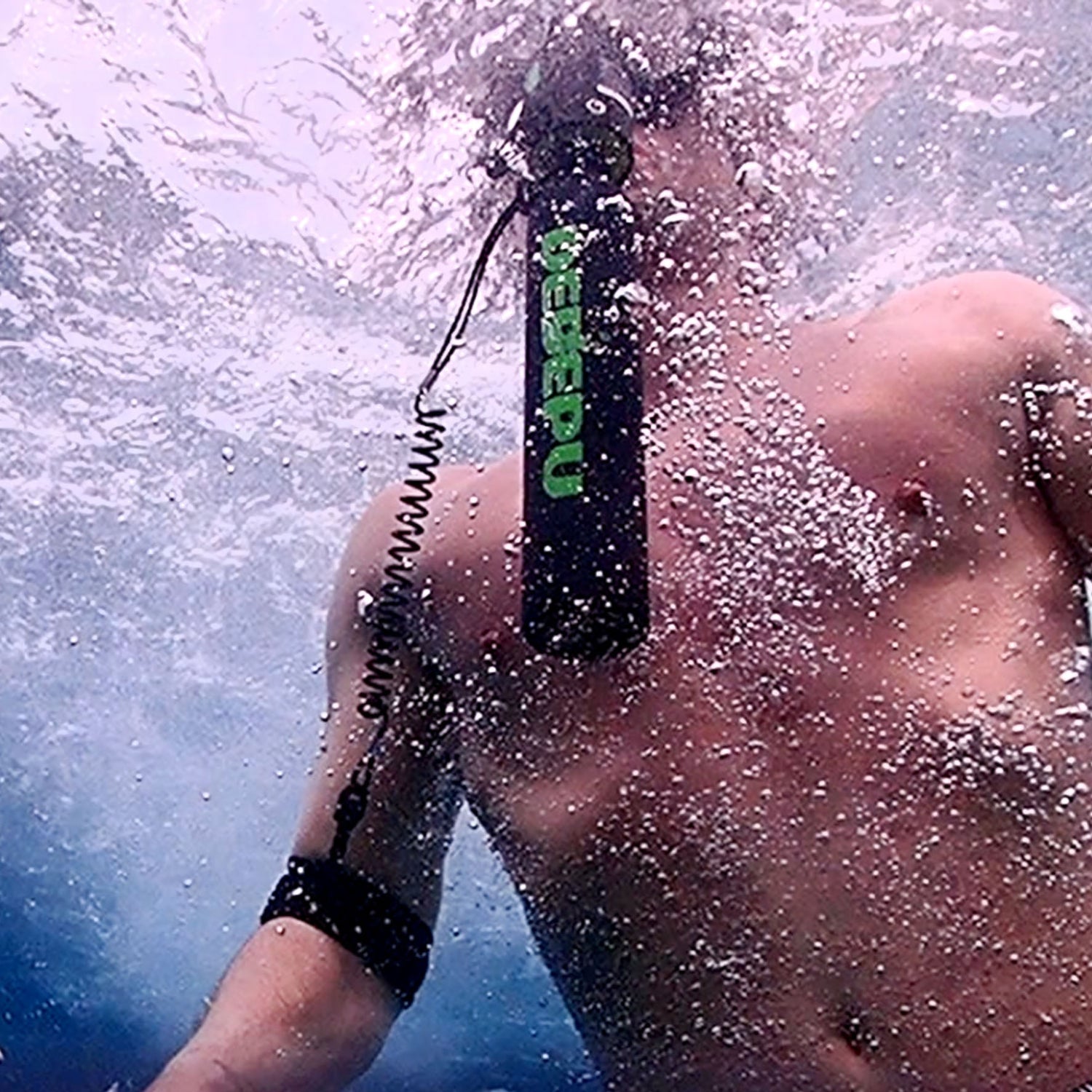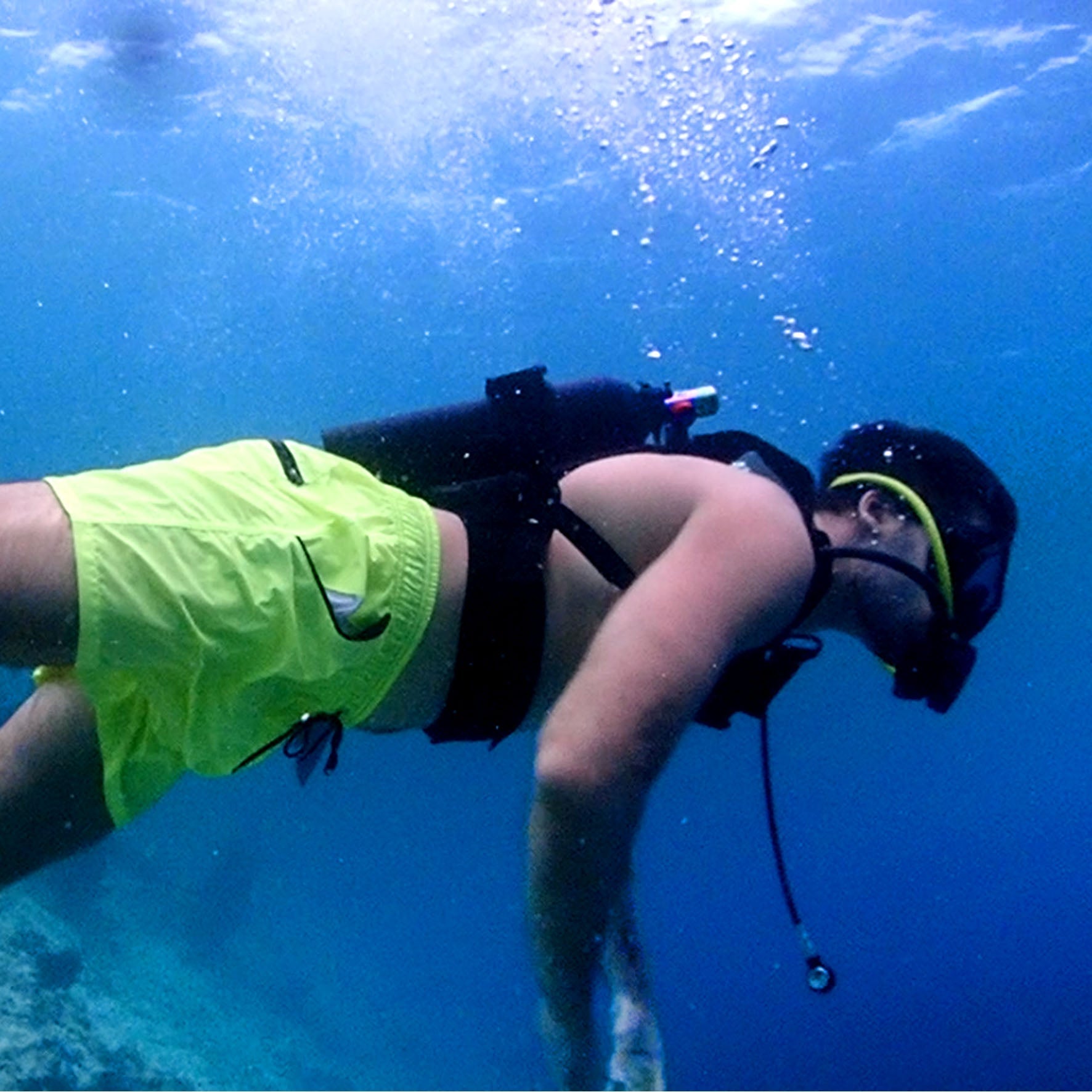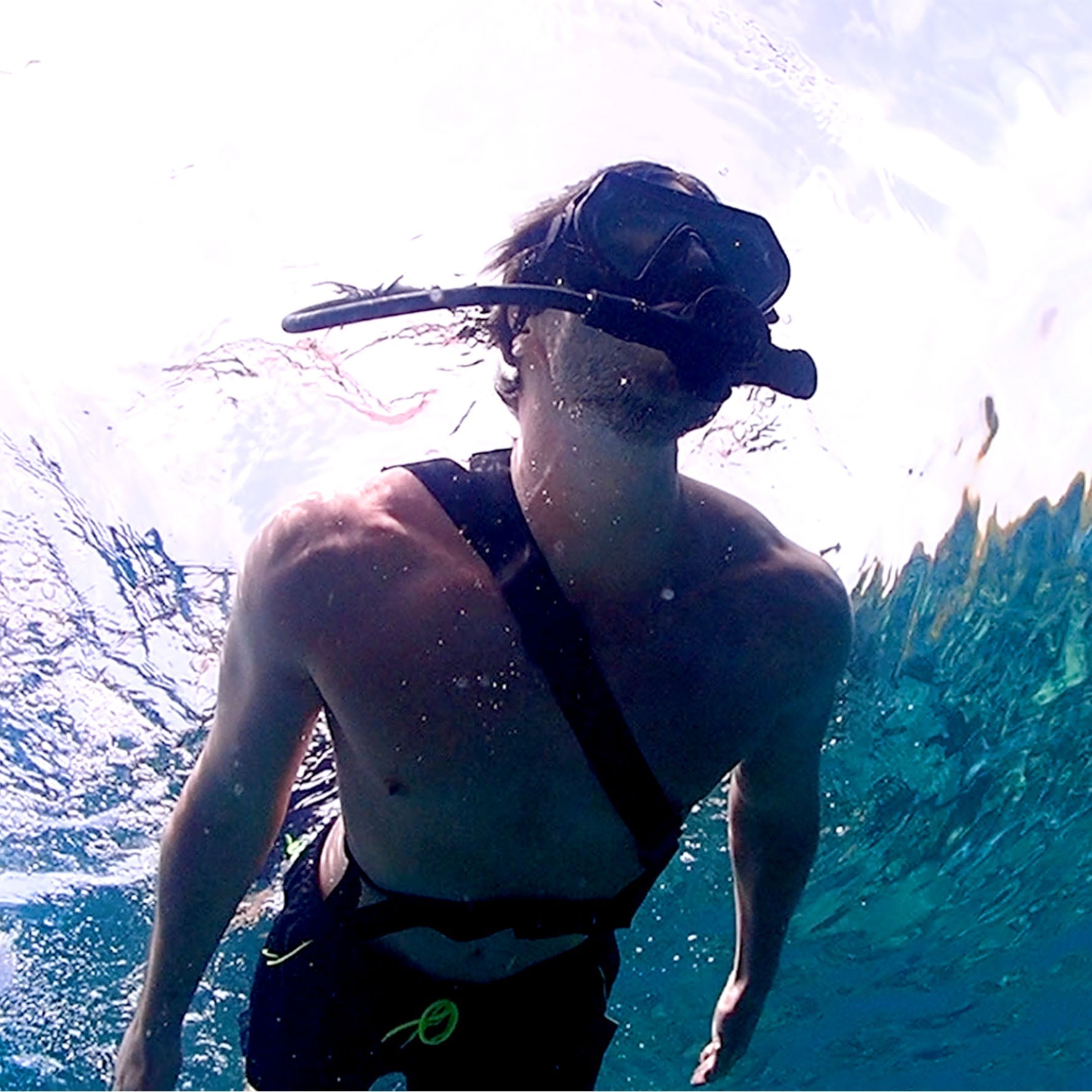Diving with 100% oxygen may seem like a good idea—after all, more oxygen means longer bottom time, right? Wrong. Below 10 meters (33 feet), pure oxygen becomes toxic, risking seizures or lung damage due to central nervous system (CNS) toxicity. Recreational divers typically use air (21% oxygen) or enriched air nitrox (up to 40% oxygen) to stay within safe limits. Technical divers follow strict oxygen exposure tables, limiting 100% oxygen to shallow decompression stops above 6 meters (20 feet). Even equipment handling is riskier—pure oxygen increases fire hazards if not stored properly.
Oxygen Toxicity
Breathing 100% oxygen underwater isn’t just risky—it can be deadly below 10 meters (33 feet). Why? Because under pressure, oxygen becomes toxic to your nervous system. At 1.4 bar partial pressure (PPO₂), the risk of seizures spikes—equivalent to breathing pure oxygen at just 5.6 meters (18 feet). By 1.6 PPO₂, the danger is severe, with symptoms like twitching, dizziness, and blackouts occurring in 5-30 minutes for some divers.
The deeper you go, the faster oxygen toxicity hits. At 20 meters (66 feet), pure oxygen reaches 3.0 PPO₂, a level where 50% of divers could experience convulsions within 10 minutes. That’s why military and technical divers strictly limit 100% oxygen use to shallow decompression stops (3-6 meters / 10-20 feet) and switch to safer gas mixes like Nitrox 32-40% for deeper dives.
How Depth Changes Oxygen’s Danger
Pressure Multiplies Toxicity
At sea level (1 atm), 100% oxygen is safe for short periods (e.g., hospital use).
At 10 meters (2 atm), the same gas becomes twice as toxic, increasing seizure risk.
At 30 meters (4 atm), oxygen toxicity can strike in under 5 minutes.
Exposure Time Matters
5 minutes at 1.6 PPO₂ (6m/20ft on pure O₂) = low risk.
30 minutes at 1.4 PPO₂ (10m/33ft on air) = moderate risk.
10 minutes at 2.0 PPO₂ (20m/66ft on 50% Nitrox) = high risk.
Individual Tolerance Varies
Some divers show symptoms at 1.2 PPO₂, while others handle 1.6 PPO₂ without issues.
Cold, fatigue, and CO₂ buildup lower your threshold, increasing danger.
Real-World Limits for Divers
Recreational divers keep PPO₂ below 1.4 (e.g., 32% Nitrox max at 30m).
Technical divers use oxygen only above 6m (20ft) for decompression.
Military rebreathers monitor PPO₂ in real-time, keeping it below 1.3 during descent.
Oxygen toxicity isn’t a myth—it’s a predictable, depth-dependent risk. Ignoring the numbers can turn a routine dive into an emergency.
Safe Oxygen Limits for Divers
Diving isn't just about how deep you go—it's about how much oxygen you breathe at each depth. Push the limits, and you risk seizures, lung damage, or worse. That's why divers follow strict oxygen exposure tables, keeping the partial pressure of oxygen (PPO₂) in check.
The golden rule? Never exceed 1.4 PPO₂ during the dive and 1.6 PPO₂ during decompression. Here's what that means in real terms:
Breathing air (21% oxygen) at 56 meters (185 feet) hits 1.4 PPO₂—the absolute max for recreational divers.
Using 32% Nitrox? Your max depth drops to 34 meters (112 feet) to stay under 1.4 PPO₂.
At 40% Nitrox, you can't go deeper than 27 meters (89 feet) safely.
Go beyond these limits, and the risk spikes fast. At 1.6 PPO₂, 5-10% of divers experience symptoms like twitching or dizziness within 30 minutes. At 2.0 PPO₂, seizures become 50% more likely in just 10 minutes.
The science behind oxygen limits comes from decades of dive medicine research. When you descend, the increasing pressure causes oxygen molecules to become more reactive in your body. At 1.4 PPO₂, this reaches the threshold where 5% of divers may show early signs of toxicity—visual disturbances, nausea, or muscle twitches. Push to 1.6 PPO₂, and that risk jumps to 10-15%, with symptoms appearing 2-3 times faster in cold water or during strenuous activity.
Key factors that affect safe oxygen limits:
Depth: Every 10 meters doubles the PPO₂ of your breathing gas
Gas mixture: 100% O₂ becomes toxic at just 6m, while 21% air is safe to 56m
Exposure time: 30 minutes at 1.4 PPO₂ is considered the recreational limit
Individual factors: Age, fatigue, and CO₂ retention lower your tolerance
Commercial and military diving operations use even more conservative limits. The US Navy sets their maximum operating PPO₂ at 1.3 for working dives, with 1.2 PPO₂ as the standard for saturation systems. This 0.1 reduction accounts for the cumulative effect of multiple dives—oxygen toxicity is dose-dependent, meaning each exposure adds to your risk.
Modern dive computers track this through OTU (Oxygen Toxicity Units) calculations. They measure:
% of maximum allowed exposure during the dive
CNS clock counting down from 100% tolerance
Real-time PPO₂ monitoring in closed-circuit rebreathers
The consequences of ignoring these limits are well-documented. In one study of diving accidents, 72% of oxygen toxicity cases occurred when divers exceeded 1.6 PPO₂, with 40% resulting in underwater seizures. The average depth for these incidents was just 28 meters—shallow enough that many divers assume they're safe.
For recreational divers, the solution is simple:
Always analyze your gas mix before diving
Set your computer's PO₂ alarm to 1.4
When diving Nitrox, recalculate your maximum depth if you change mixtures
Allow at least 18 hours between dives using elevated oxygen levels
Technical divers take additional precautions. They typically:
Use separate tanks for bottom mix and decompression gas
Switch to pure oxygen only when shallower than 6 meters
Carry backup oxygen sensors in rebreather systems
Plan dives to keep cumulative CNS exposure below 80%
The numbers don't lie—oxygen limits exist because they work. Following them reduces your risk of toxicity to less than 1%, while ignoring them can increase that risk to over 50% on deep dives. It's not just about rules; it's about understanding how your body reacts to pressurized oxygen at every meter of depth.

Seizures Underwater
An underwater seizure isn’t just scary—it’s often deadly. When oxygen toxicity triggers convulsions at depth, the drowning risk exceeds 80% because you can’t control your breathing or keep your regulator in place. Studies show that at 1.6 PPO₂, roughly 1 in 10 divers will experience symptoms within 30 minutes, and by 2.0 PPO₂, that risk jumps to 50% in just 10 minutes.
The danger escalates fast with depth. At 20 meters (66 feet), breathing 50% Nitrox creates a 2.0 PPO₂ environment—where seizures can strike without warning. Even military divers, who train for high-oxygen exposures, strictly limit time above 1.3 PPO₂ because data shows a 15% seizure rate beyond that threshold.
The mechanics of an oxygen-induced seizure are brutally efficient. As PPO₂ rises, electrical activity in the brain becomes unstable, leading to sudden, uncontrollable muscle contractions. At 1.6 PPO₂, symptoms typically follow this timeline:
5-15 minutes: Visual disturbances (tunnel vision, flashes)
10-20 minutes: Nausea, dizziness, or ringing ears
20-30 minutes: Twitching (especially lips/fingers) preceding full convulsions
Depth dramatically shortens this window. While a diver at 10 meters on pure O₂ might take 30+ minutes to show symptoms, the same diver at 20 meters could seize in under 5 minutes. Cold water worsens the risk—studies indicate twice the seizure likelihood below 15°C (59°F) due to vasoconstriction and CO₂ buildup.
Critical risk factors for underwater seizures:
PPO₂ level:
1.4 = <1% seizure risk (recreational limit)
1.6 = 10% risk
2.0 = 50% risk
Exposure duration:
30min @ 1.6 PPO₂ = 10% symptom rate
60min @ 1.6 PPO₂ = 25% symptom rate
Individual variability:
5% of divers react abnormally even at 1.4 PPO₂
Prior neurological issues triple the risk
Rebreather accident reports reveal how quickly things go wrong. In 68% of cases, seizures occurred:
During ascent, when falling pressure increased the effective PPO₂
After unplanned exertion, which raised CO₂ levels
In <10 minutes at depths between 12-25 meters
Survival statistics are grim. Without immediate buddy intervention:
90% of seizure victims drown within 2 minutes
Even with rescue, 30% suffer permanent brain damage from hypoxia
Dive computers now track CNS% accumulation, but their models aren’t perfect. Real-world data shows:
40% of seizures happen below the computer’s warning threshold
Delay errors of just 2-3 minutes in PPO₂ calculation can be fatal
Equipment Risks
Pure oxygen doesn't just threaten your body—it transforms ordinary dive gear into a fire hazard. At 1 atmosphere, materials that are safe in air become flammable in 100% O₂ environments, with ignition temperatures dropping by 200-300°C. Industry reports show 62% of oxygen-related diving accidents involve equipment fires, often starting from:
Valve friction during tank opening (35% of incidents)
Contaminated regulators with oil residue (28%)
Improper storage near heat sources (22%)
The numbers prove how fast things escalate:
A 2mm grease spot in high-pressure O₂ can ignite at just 7 bar (100 psi)
Aluminum regulators burn at 1,200°C in pure oxygen—3x hotter than in air
Fire spreads 10x faster in pressurized O₂ systems compared to normal air
Material compatibility makes the first line of defense. Standard scuba gear rated for 21-40% oxygen fails catastrophically above 60% concentration:
Buna-N o-rings degrade 8x faster in pure O₂, lasting <50 dives vs. 300+ in air
Brass components must meet CGA G-4.4 standards, with copper content >85% to resist ignition
Stainless steel becomes hazardous above 300 bar, requiring specialized passivation
The physics of oxygen fires explains why they're so dangerous:
Pressure dependency
At 50 bar, ignition energy drops to <1 millijoule (static shock can spark fires)
Every 10°C temperature increase doubles reaction rates in O₂ systems
Contamination thresholds
0.01mg/cm² of hydrocarbon residue exceeds safe limits
5ppm oil vapor in filling systems can trigger explosions
Component failure modes
Regulator seats wear 40% faster in high-O₂ service
Valve stems scoring deeper than 0.05mm create ignition points
Real-world failure data from commercial diving shows:
72% of O₂ fires occur during filling operations
55% involve improperly cleaned equipment
Average damage cost per incident: $18,000
Critical handling protocols that prevent disasters:
Cleaning standards
ASTM G93 Level 1 for >80% O₂ systems
Residual hydrocarbon limits: <0.1mg/m²
Maintenance intervals
O₂ service regulators rebuilt every 50 hours
Tank valves inspected after 5 fills
Operational safeguards
Slow opening (<1/4 turn per second) of O₂ valves
Leak checks at <10% working pressure
No substitutions - dedicated O₂-compatible tools
Rebreather users face 3x higher fire risk than open-circuit divers due to:
Constant high-PPO₂ exposure (1.3-1.6 bar typical)
Moisture accumulation promoting corrosion
200+ ignition points in electronic control systems
The military's O₂ safety manual proves what works:
Zero synthetic lubricants - only approved Krytox grease
Copper-alloy mesh filters on all fill stations
Annual X-ray inspections for stress fractures
For recreational divers handling Nitrox:
Never modify air-filled equipment for high O₂
Verify cleaning certificates before first use
Replace o-rings every 2 years regardless of wear

Better Alternatives
Divers don’t need 100% oxygen to stay safe—they need the right mix for the right depth. Standard air (21% O₂) remains the most widely used gas, but Nitrox (22-40% O₂) offers measurable benefits with lower risks.
Nitrox 32 extends no-decompression limits by 15-20% at 18-30m (60-100ft) compared to air
Nitrox 36 reduces nitrogen absorption by 30%, cutting surface intervals nearly in half
Air remains safer below 40m (130ft), where oxygen toxicity risks outweigh Nitrox benefits
Costs are reasonable too:
Filling Nitrox adds $5-10 per tank over air
Specialized training runs $200-300, but pays off in 3-5 dive trips through saved deco time
Nitrox isn’t just "safer air"—it’s a calculated trade-off. The higher oxygen percentage reduces nitrogen loading, which means:
Longer bottom times before hitting no-deco limits
Shorter surface intervals (often 45 minutes instead of 60+ on air)
Lower DCS risk—studies show 25% fewer incidents among Nitrox divers
But it’s not magic. Each blend has strict depth limits:
Nitrox 32: Max depth 34m (112ft) at 1.4 PPO₂
Nitrox 36: Max depth 29m (95ft)
Nitrox 40: Max depth 24m (79ft)—best for shallow reef dives
Air still dominates deep diving for good reason:
At 50m (165ft), air’s 21% O₂ keeps PPO₂ at 1.05—well below toxic levels
Helium mixes (Trimix) take over below 50m, but air remains the budget option
No blending required—fills cost 50-60% less than Nitrox
Real-world performance comparisons:
60-minute dive at 20m (66ft)
Air: Hits no-deco limit at 60 mins
Nitrox 32: Allows 75-80 mins before deco
Multi-dive day (3 dives to 18m/60ft)
Air: Requires 1h+ surface intervals
Nitrox 36: Cuts intervals to 40-45 mins
Cost efficiency matters too:
Recreational divers doing <20 dives/year break even on Nitrox costs in 2 seasons
Frequent divers (50+ dives/year) save $500+ annually in saved tank fills and time
The verdict?
<30m dives: Nitrox 32-36 is optimal
30-40m dives: Air or Nitrox 21-28 (custom blends)
>40m dives: Air or Trimix
Bottom line: Nitrox and air aren’t competitors—they’re tools for different jobs. The data proves it: right gas, right depth, zero guesswork.




Leave a comment
All comments are moderated before being published.
This site is protected by hCaptcha and the hCaptcha Privacy Policy and Terms of Service apply.